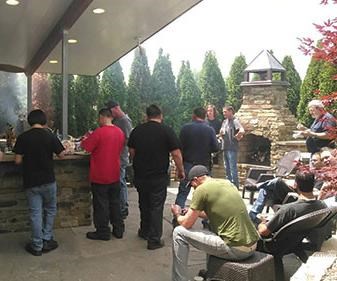Krieger Craftsmen Rebuilds Culture to Drive Success
After weathering the 2009 recession, the company instituted steps toward a more positive company culture that translated into increased profitability.
Mold builders who participate in industry events, such as an American Mold Builders Association (AMBA) conference, will often come away from the experience saying they feel impressed, inspired and ready to take what they learned and apply it at their companies. Tim Krieger, owner and president of Krieger Craftsmen in Grand Rapids, Michigan, counts himself among those people. The theme of the AMBA’s 2013 conference focused on company culture: the values and practices shared by an organization’s employees. After listening to speakers at this event, he returned to his company and set out to rebuild its culture from top to bottom.
“At the time, we were in the final recovery stages after difficulties created by the 2009 recession,” Krieger says. “I needed to figure out how to regain a competitive edge and rebuild the company for growth. The conference topic and timing was perfect.”
Krieger listened as noted motivational speaker Jack Daly gave the first keynote presentation, titled “Building a High Performance Culture,” and that presentation, he says, really struck a chord with him. “Daly said, ‘Your business plan is what you are; your culture is who you are. You want to be the employer of choice, and to get the culture right you must share the vision and paint the picture clearly for your people and never give up.’”
Learning from Peers
Beyond Daly’s tips for creating a company culture that is positive, strong and, as a result, profit-generating, Krieger was perhaps more profoundly influenced by peers who gave presentations at the conference about their companies and how they had carved out cultures that drive not just better productivity but a more meaningful professional experience for every employee.
“Some of the testimonials given by my successful peers really hit me,” Krieger says. “For example, one shared a story of how, after so many years of service, one of his employees passed away and the family invited him to their home after the funeral. While there, he saw a note that he had written to that employee some years before framed on the wall. It took him aback, because it had taken him only a minute to write that note, but look how it was received.”
Krieger says he was so moved by this anecdote that he went back to his shop and shared the story with his administrative assistant. He ordered cards embossed with the company’s logo and had printed inside: “The greatest asset a company can ever hope to retain is its valued people.” One of the occasions he marks with these cards is an employee’s anniversary with the company. “This gives me an opportunity to write a note of gratitude at least once a year, and I mail them directly to their homes so that their families can share in the recognition,” he explains. “It’s important for me to thank my employees for work well done.”
Krieger also toured a couple of Chicago-area shops to see firsthand how they are trying to enrich their employees’ work environments. At both A-1 Tool of Melrose Park and Craftsman Tool and Mold of Aurora, he saw how certain benefits boosted worker morale, and he says it inspired him to try similar methods at his own company. Although his recently purchased building was undergoing renovations to the front office, he put those on hold to create a “Tranquility Patio” for the enjoyment of his employees. This private, covered area features landscaping, a waterfall, an outdoor fireplace, and a grilling station with a sink and countertop. Employees are strongly encouraged to bring their families in for lunch or dinner on the patio.
“We spend more time at the shop than we do with our families at home,” he says. “Our guys are working so many hours each week, sometimes 12-15 hours a day.”
And improvements geared to employee well-being didn’t stop with the patio. Krieger also installed four 25-ton clean air conditioning exchange units that monitor the air temperature and quality. When these units sense excess smoke and other irritants in the air caused by roughing and other machining processes, dampeners open and close, bringing in as much as 25 percent fresh air and creating a cleaner, healthier environment for the employees. In addition, a climate control unit stabilizes thermal expansion and contraction due to temperature variances in the work environment, which Krieger says helps keep production quality and tolerances on target. “CNC machines put out quite a bit of heat. If you don’t control that, you compromise quality,” he explains.
These changes Krieger has instituted are steps toward a more positive company culture that one could expect to translate into increased profitability. “Our company depends on our people. You must have good equipment and great people to excel at what you do,” Krieger says.
“Our employees know we have to present ourselves to the customer as a shop that can fulfill a promise. I’m proud to say I have a loyal, honest team with a good work ethic. They’re proud of what they do, and they care. The success of our company rests on that.”
Related Content
Making Quick and Easy Kaizen Work for Your Shop
Within each person is unlimited creative potential to improve shop operations.
Read MoreDynamic Tool Corporation – Creating the Team to Move Moldmaking Into the Future
For 40+ years, Dynamic Tool Corp. has offered precision tooling, emphasizing education, mentoring and innovation. The company is committed to excellence, integrity, safety and customer service, as well as inspiring growth and quality in manufacturing.
Read MoreMaking Mentoring Work | MMT Chat Part 2
Three of the TK Mold and Engineering team in Romeo, Michigan join me for Part 2 of this MMT Chat on mentorship by sharing how the AMBA’s Meet a Mentor Program works, lessons learned (and applied) and the way your shop can join this effort.
Read MoreTop 10 Topics to Cover During an ISO 9001 Manufacturing Audit
Take a look at this practical hands-on approach to conducting a quality audit.
Read MoreRead Next
Creating Culture
Cultivating a team environment lightens the load on the individual person and distributes it among many, enabling faster lead times and better-quality products.
Read MoreAre You a Moldmaker Considering 3D Printing? Consider the 3D Printing Workshop at NPE2024
Presentations will cover 3D printing for mold tooling, material innovation, product development, bridge production and full-scale, high-volume additive manufacturing.
Read MoreReasons to Use Fiber Lasers for Mold Cleaning
Fiber lasers offer a simplicity, speed, control and portability, minimizing mold cleaning risks.
Read More






















